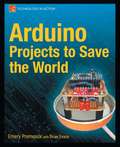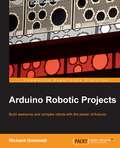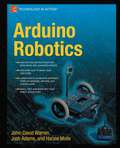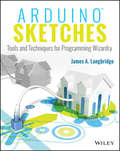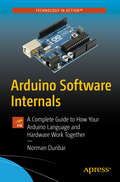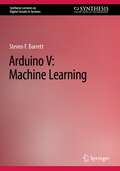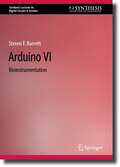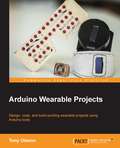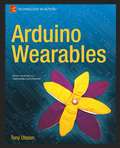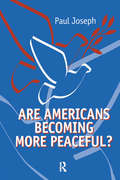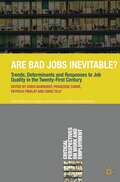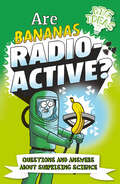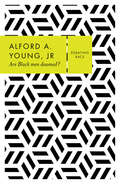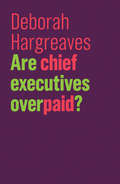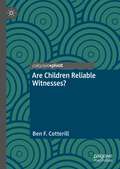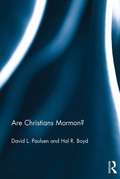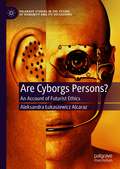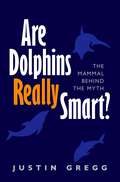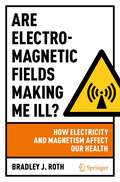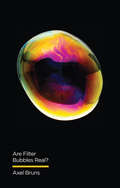- Table View
- List View
Arduino Projects to Save the World
by Emery Premeaux Brian EvansArduino Projects to Save the World shows that it takes little more than a few tools, a few wires and sensors, an Arduino board, and a bit of gumption to build devices that lower energy bills, help you grow our own food, monitor pollution in the air and in the ground, even warn you about earth tremors. Arduino Projects to Save the World introduces the types of sensors needed to collect environmental data—from temperature sensors to motion sensors. You'll see projects that deal with energy sources—from building your own power strip to running your Arduino board on solar panels so you can actually proceed to build systems that help, for example, to lower your energy bills. Once you have some data, it's time to put it to good use by publishing it online as you collect it; this book shows you how. The core of this book deals with the Arduino projects themselves: Account for heat loss using a heat loss temperature sensor array that sends probes into every corner of your house for maximum measurement. Monitor local seismic activity with your own seismic monitor. Keep your Arduino devices alive in the field with a solar powered device that uses a smart, power-saving design. Monitor your data and devices with a wireless radio device; place your sensors where you like without worrying about wires. Keep an eye on your power consumption with a sophisticated power monitor that records its data wherever you like. Arduino Projects to Save the World teaches the aspiring green systems expert to build environmentally-sound, home-based Arduino devices. Saving the world, one Arduino at a time. Please note: the print version of this title is black & white; the eBook is full color.
Arduino Robotic Projects
by Richard GrimmettThis book is for anyone who has been curious about using Arduino to create robotic projects that were previously the domain of research labs of major universities or defense departments. Some programming background is useful, but if you know how to use a PC, you can, with the aid of the step-by-step instructions in this book, construct complex robotic projects that can roll, walk, swim, or fly.
Arduino Robotics
by John-David Warren Josh Adams Harald MolleThis book will show you how to use your Arduino to control a variety of different robots, while providing step-by-step instructions on the entire robot building process. You'll learn Arduino basics as well as the characteristics of different types of motors used in robotics. You also discover controller methods and failsafe methods, and learn how to apply them to your project. The book starts with basic robots and moves into more complex projects, including a GPS-enabled robot, a robotic lawn mower, a fighting bot, and even a DIY Segway-clone. Introduction to the Arduino and other components needed for robotics Learn how to build motor controllers Build bots from simple line-following and bump-sensor bots to more complex robots that can mow your lawn, do battle, or even take you for a ride Please note: the print version of this title is black & white; the eBook is full color.
Arduino Sketches: Tools and Techniques for Programming Wizardry
by James A. LangbridgeMaster programming Arduino with this hands-on guide Arduino Sketches is a practical guide to programming the increasingly popular microcontroller that brings gadgets to life. Accessible to tech-lovers at any level, this book provides expert instruction on Arduino programming and hands-on practice to test your skills. You'll find coverage of the various Arduino boards, detailed explanations of each standard library, and guidance on creating libraries from scratch – plus practical examples that demonstrate the everyday use of the skills you're learning. Work on increasingly advanced programming projects, and gain more control as you learn about hardware-specific libraries and how to build your own. Take full advantage of the Arduino API, and learn the tips and tricks that will broaden your skillset. The Arduino development board comes with an embedded processor and sockets that allow you to quickly attach peripherals without tools or solders. It's easy to build, easy to program, and requires no specialized hardware. For the hobbyist, it's a dream come true – especially as the popularity of this open-source project inspires even the major tech companies to develop compatible products. Arduino Sketches is a practical, comprehensive guide to getting the most out of your Arduino setup. You'll learn to: Communicate through Ethernet, WiFi, USB, Firmata, and Xbee Find, import, and update user libraries, and learn to create your own Master the Arduino Due, Esplora, Yun, and Robot boards for enhanced communication, signal-sending, and peripherals Play audio files, send keystrokes to a computer, control LED and cursor movement, and more This book presents the Arduino fundamentals in a way that helps you apply future additions to the Arduino language, providing a great foundation in this rapidly-growing project. If you're looking to explore Arduino programming, Arduino Sketches is the toolbox you need to get started.
Arduino Sketches: Tools and Techniques for Programming Wizardry
by James A. LangbridgeMaster programming Arduino with this hands-on guide Arduino Sketches is a practical guide to programming the increasingly popular microcontroller that brings gadgets to life. Accessible to tech-lovers at any level, this book provides expert instruction on Arduino programming and hands-on practice to test your skills. You'll find coverage of the various Arduino boards, detailed explanations of each standard library, and guidance on creating libraries from scratch – plus practical examples that demonstrate the everyday use of the skills you're learning. Work on increasingly advanced programming projects, and gain more control as you learn about hardware-specific libraries and how to build your own. Take full advantage of the Arduino API, and learn the tips and tricks that will broaden your skillset. The Arduino development board comes with an embedded processor and sockets that allow you to quickly attach peripherals without tools or solders. It's easy to build, easy to program, and requires no specialized hardware. For the hobbyist, it's a dream come true – especially as the popularity of this open-source project inspires even the major tech companies to develop compatible products. Arduino Sketches is a practical, comprehensive guide to getting the most out of your Arduino setup. You'll learn to: Communicate through Ethernet, WiFi, USB, Firmata, and Xbee Find, import, and update user libraries, and learn to create your own Master the Arduino Due, Esplora, Yun, and Robot boards for enhanced communication, signal-sending, and peripherals Play audio files, send keystrokes to a computer, control LED and cursor movement, and more This book presents the Arduino fundamentals in a way that helps you apply future additions to the Arduino language, providing a great foundation in this rapidly-growing project. If you're looking to explore Arduino programming, Arduino Sketches is the toolbox you need to get started.
Arduino Software Internals: A Complete Guide to How Your Arduino Language and Hardware Work Together
by Norman DunbarIt’s not enough to just build your Arduino projects; it’s time to actually learn how things work! This book will take you through not only how to use the Arduino software and hardware, but more importantly show you how it all works and how the software relates to the hardware.Arduino Software Internals takes a detailed dive into the Arduino environment. We’ll cover the Arduino language, hardware features, and how makers can finally ease themselves away from the hand holding of the Arduino environment and move towards coding in plain AVR C++ and talk to the microcontroller in its native language. What You’ll Learn:How the Arduino Language interfaces with the hardware, as well as how it actually works in C++;How the compilation system works, and how kit can be altered to suit personal requirements;A small amount of AVR Assembly Language;Exactly how to set up and use the various hardware features of the AVR without needing to try and decode the data sheets – which are often bug ridden and unclear;Alternatives to the Arduino IDE which might give them a better workflow;How to build their own Arduino clone from scratch.Who This Book Is For: No expertise is required for this book! All you need is an interest in learning about what you’re making with Arduinos and how they work. This book is also useful for those looking to understand the AVR microcontroller used in the Arduino boards. In other words, all Makers are welcome!
Arduino Software Internals: A Complete Guide to How Your Arduino Language and Hardware Work Together (Maker Innovations Series)
by Norman Dunbar"It's not enough to just build your Arduino projects; it's time to actually learn how things work!" This book goes beyond the basics, providing a comprehensive understanding of Arduino software and hardware, as well as how they intertwine. Gain valuable insights into the inner workings of Arduino and its language, and discover how to communicate with the microcontroller in its native language, AVR C++.Explore the latest version (0.30.0) which offers a multitude of configuration options that can be conveniently modified using the command-line interface (CLI).What You’ll Learn:How the Arduino Language interfaces with the hardware, as well as how it actually works in C++;How to burn bootloaders with the latest version (0.30.0) of Arduino software.How to program your device using an In Circuit System Programmer (ICSP)How to build their own Arduino clone from scratchHow to efficiently handle different boards and libraries Uncover new features and enhancements, including the ability to set up and use profiles, and employ Makefiles.Who This Book Is For: This book welcomes everyone with an interest in learning about Arduino, regardless of expertise. Whether you're a beginner or an experienced Maker, "Arduino Software Internals" equips you with the knowledge to truly comprehend and leverage the power of Arduino.
Arduino V: Machine Learning (Synthesis Lectures on Digital Circuits & Systems)
by Steven F. BarrettThis book is about the Arduino microcontroller and the Arduino concept. The visionary Arduino represented a new innovation in microcontroller hardware in 2005, the concept of open source hardware, making a broad range of computing accessible for all.This book, “Arduino V: AI and Machine Learning,” is an accessible primer on Artificial Intelligence and Machine Learning for those without a deep AI and ML background. The author concentrates on Artificial Intelligence (AI) and Machine Learning (ML) applications for microcontroller–based systems. The intent is to introduce the concepts and allow readers to practice on low cost, accessible Arduino hardware and software. Readers should find this book a starting point, an introduction, to this fascinating field. A number of references are provided for further exploration.
Arduino VI: Bioinstrumentation (Synthesis Lectures on Digital Circuits & Systems)
by Steven F. BarrettThis book is about the Arduino microcontroller and the Arduino concept. The visionary Arduino team represented a new innovation in microcontroller hardware in 2005, the concept of open source hardware, making a broad range of computing accessible for all. This book, “Arduino VI: Bioinstrumentation,” is an accessible primer on bioinstrumentation for those without a deep instrumentation background. An understanding of basic circuit theory is an appropriate prerequisite for the book. The three main goals for the book are: explore accessible Arduino microcontroller programming and interfacing concepts; investigate the source and measurement of biomedical signals; and develop skills to design and implement biomedical instrumentation.
Arduino Wearable Projects
by Tony OlssonDesign, code, and build exciting wearable projects using Arduino tools About This Book • Develop an interactive program using sensors and actuators suitable with wearables • Understand wearable programming with the help of hands-on projects • Explore different wearable design processes in the Arduino platform and customize them to fit your individual needs Who This Book Is For This book is intended for readers who are familiar with the Arduino platform and want to learn more about creating wearable projects. No previous experience in wearables is expected, although a basic knowledge of Arduino programming will help. What You Will Learn • Develop a basic understanding of wearable computing • Learn about Arduino and its compatible prototyping platforms suitable for creating wearables • Understand the design process surrounding the creation of wearable objects • Gain insight into the materials suitable for developing wearable projects • Design and create projects including interactive bike gloves, GPRS locator watch, and more using various kinds of electronic components • Discover programming for interactivity • Learn how to connect and interface wearables' with Bluetooth and WiFi • Get your hands dirty with your own personalized designs In Detail The demand for smart wearable technologies is becoming more popular day by day. The Arduino platform was developed keeping wearables, such as watches that track your location or shoes that count the miles you've run, in mind. It is basically an open-source physical computing platform based on a simple microcontroller board and a development environment in which you create the software for the board. If you're interested in designing and creating your own wearables, this is an excellent platform for you. This book provides you with the skills and understanding to create your own wearable projects. The book covers different prototyping boards which are compatible with the Arduino platform and are suitable for creating wearable projects. Each chapter of the book covers a project in which knowledge and skills are introduced gradually, making the book suitable for all kinds of readers. You begin your journey with understanding electronic components, including LEDs and sensors, to get yourself up to scratch and comfortable with different components. You will then gain hands-on experience by creating your very first wearable project, a pair of interactive bike gloves that help you cycle at night. This is followed by a project making your own funky LED glasses and a cool GPS watch. You'll also delve into other projects including creating your own keyless doorlock, wearable NFC tags, a fitness-tracking device, and a WiFi-enabled spark board. The final project is a compilation of the previous concepts used where you make your own smart watch with fitness tracking, internet-based notifications, GPS, and of course time telling. Style and approach This is a project-based book that introduces each project to the reader step-by-step. Each project starts out by covering all the components individually, and then explains how to combine them into interactive objects. Each project contains an easy-to-follow guide to design and implement the electronics into wearable objects.
Arduino Wearables
by Tony OlssonYou've probably seen LED-decorated t-shirts and hats, and maybe even other electronic gadgets embedded in clothing, but with Arduino Wearables you can learn to make your own wearable electronic creations. This book is an introduction to wearable computing, prototyping, and smart materials using the Arduino platform. Every chapter takes you all the way from idea to finished project. Even if you have no experience with Arduino, this book will get you set up with all the materials, software, and hardware you need; you'll complete simple projects first, and then build on your growing expertise to make more complex projects. By the end of the book, you'll have learned: Electronics basics How to prototype successfully Arduino programming How to design and build your own wearable Arduino creations Along the way you'll create fun and inspiring wearables, such as: An LED bracelet: learn the basics of wearable electronics A synthesizer tie: accept user input and create output in response A solar-powered glow in the dark bag: create self-sufficient wearables A shape memory flower: store state and manipulate your wearables An EL wire dress: add designer touches to your wearables A beatbox hoodie: use a voice-activated sequencer and skin resistance to create the coolest of urban wearables Arduino Wearables is the complete guide to getting started with Arduino and wearable computing. The 10 inspiring projects to make, learn from, and build upon will equip you for creating your own projects; the only limit is your imagination.
Are Americans Becoming More Peaceful?
by Paul Joseph"It's time that someone broke into the general gloom created by a war-loving administration and reminded us that we are a peace-loving people. Paul Joseph's book does just that, not with fantasy but with facts, showing how the public antipathy to war, suppressed too long by propaganda and deception, is coming to the surface, and offers hope." Howard Zinn "In this antidote to despair, Joseph shows how even the most sophisticated efforts of US political and military leaders to maintain public support for war are flawed and doomed to failure in the face of an increasingly skeptical public that is unwilling to accept the costs." William A. Gamson, Boston College "An original and thought-provoking perspective on one of the most important issues in American politics today." Michael Klare, Hampshire College Are Americans becoming more peaceful -- even after the 2004 elections and the seeming affirmation of the war in Iraq? This book looks at the meaning of peace in the face of war and offers an optimistic interpretation of the public's changing views. US citizens are becoming increasingly uncomfortable with the costs of war that can be measured not just in dollars but in lives and international respect. Americans are becoming ever more resistant to government management of the "facts" surrounding war. In areas ranging from media and photojournalism to gender and casualties, Joseph exposes the reality of popular opposition to war.
Are Americans Becoming More Peaceful?
by Paul Joseph"It's time that someone broke into the general gloom created by a war-loving administration and reminded us that we are a peace-loving people. Paul Joseph's book does just that, not with fantasy but with facts, showing how the public antipathy to war, suppressed too long by propaganda and deception, is coming to the surface, and offers hope." Howard Zinn "In this antidote to despair, Joseph shows how even the most sophisticated efforts of US political and military leaders to maintain public support for war are flawed and doomed to failure in the face of an increasingly skeptical public that is unwilling to accept the costs." William A. Gamson, Boston College "An original and thought-provoking perspective on one of the most important issues in American politics today." Michael Klare, Hampshire College Are Americans becoming more peaceful -- even after the 2004 elections and the seeming affirmation of the war in Iraq? This book looks at the meaning of peace in the face of war and offers an optimistic interpretation of the public's changing views. US citizens are becoming increasingly uncomfortable with the costs of war that can be measured not just in dollars but in lives and international respect. Americans are becoming ever more resistant to government management of the "facts" surrounding war. In areas ranging from media and photojournalism to gender and casualties, Joseph exposes the reality of popular opposition to war.
Are Bad Jobs Inevitable?: Trends, Determinants and Responses to Job Quality in the Twenty-First Century (Critical Perspectives on Work and Employment)
An edited book in the Critical Perspectives on Work and Employment Series that is associated with the annual International Labour Process Conference, it focuses on job quality: debates, developments, issues and trends; workplace practice and interventions. Written by world-leading academics, it contains cutting-edge research.
Are Bananas Radioactive?: Questions and Answers About Surprising Science (Big Ideas!)
by Anne Rooney William PotterWhat is snot made of? Can trees talk to each other? How was the Grand Canyon made?Discover the answers to these questions and more in this wild and wacky book filled with mind-blowing science facts for young readers. With an engaging Q&A format and hilarious cartoon illustrations, this book supports STEM learning and is a wonderful way to introduce scientific ideas to children in an entertaining and accessible way. Perfect for children aged 7+.ABOUT THE SERIES: Big Ideas! is a dynamic, educational "fun fact" series for children, illustrated throughout with humorous cartoons. Packed with surprising facts, stats, and records that kids will just love to share, it revels in all things weird, unexpected, mind-blowing, funny, and gross!
Are Black Men Doomed? (Debating Race)
by Alford A. Young Jr.Life for too many African American men is a battle with extreme disadvantage, a fight for survival, and a struggle for dignity in a society which labels them a "problem." For more than 30 years, most of the effort put toward addressing the crisis of Black men has centered on what they must do to improve their condition. Without neglecting that perspective, Are Black men doomed? radically shifts the focus. This urgent intervention explores how a damning portrait of Black men as incorrigibly pernicious has been built and persists, and how the voice of these men themselves has been ignored. It astutely argues that improving the prospects for Black men requires that society fully come to terms with the narrow and incomplete vision it has sustained about these men. It then shows us the means to hear, understand, and value them, offering a new vision rooted in reinterpretation and redemption.
Are Chief Executives Overpaid? (The Future of Capitalism)
by Deborah HargreavesWages for the majority have been stagnant for decades, but a lucky few have enjoyed a pay bonanza. Top company bosses take home in several days as much as most people earn in a whole year. In this hard-hitting book, Deborah Hargreaves explains why pay for the top 0.1% has sky-rocketed in the past 20 years. She gives a devastating account of how it has created a vicious circle that destabilizes our economy and undermines social cohesion, demolishing the twisted logic of the chief executives who say: ‘I’m worth it’, when that means raking in £70m a year. A rigorous exposé of the dysfunctional nature of our ‘winner-takes-all’ economy, this book debunks the myths behind top pay and examines a range of pragmatic solutions.
Are Children Reliable Witnesses?
by Ben F. Cotterill"If a child falls victim to a crime, or becomes witness to it, they may well be questioned by the police. Perhaps even tasked with selecting a suspect from a line-up. But how reliable can a child be under such strenuous circumstances?In this book, Dr. Ben Cotterill explores practices and influences that can increase or decrease the accuracy of children’s testimonies. Memory mechanisms and general developmental factors behind the capability of child witnesses are outlined, demonstrating their ability to describe or identify. Factors that affect jurors' perception of said children are also looked into in detail.There have been many instances in which poor interviewing practices with children led to false imprisonments. Said occurrences demonstrate how both situational factors and individual differences can potentially compromise children’s eyewitness performance. Based upon what we now understand, can recommendations be made, so that, in a court of law, innocence is the key to achieving justice?
Are Christians Mormon?
by David L. Paulsen Hal R. BoydIn the past, scholars and others have asked whether Mormons are Christian. This work reverses the question by asking, "are Christians Mormon?" By identifying Mormon doctrines formerly considered heretical and documenting how these doctrines have gained increasing acceptance within mainstream Christian theologies, the work presents some surprising insights. In chapters focusing on subjects such as deification, the divine feminine, and the reopening of the scriptural canon, among others, the book sets out Joseph Smith's teachings on these ideas, summarizes the criticisms of those positions, and examines trends in contemporary Christian theology that significantly converge in Joseph's direction. Exploring the convergence of contemporary Christian theology with Mormon doctrines, this book will appeal to a broad range of students and readers exploring Christian theology and the Latter-day Saint tradition.
Are Christians Mormon?: Joseph Smith And Converging Christian Theologies
by David L. Paulsen Hal R. BoydIn the past, scholars and others have asked whether Mormons are Christian. This work reverses the question by asking, "are Christians Mormon?" By identifying Mormon doctrines formerly considered heretical and documenting how these doctrines have gained increasing acceptance within mainstream Christian theologies, the work presents some surprising insights. In chapters focusing on subjects such as deification, the divine feminine, and the reopening of the scriptural canon, among others, the book sets out Joseph Smith's teachings on these ideas, summarizes the criticisms of those positions, and examines trends in contemporary Christian theology that significantly converge in Joseph's direction. Exploring the convergence of contemporary Christian theology with Mormon doctrines, this book will appeal to a broad range of students and readers exploring Christian theology and the Latter-day Saint tradition.
Are Cyborgs Persons?: An Account of Futurist Ethics (Palgrave Studies in the Future of Humanity and its Successors)
by Aleksandra Łukaszewicz AlcarazThis book presents argumentation for an evolutionary continuity between human persons and cyborg persons, based on the thought of Joseph Margolis. Relying on concepts of cultural realism and post-Darwinism, Aleksandra Łukaszewicz Alcaraz redefines the notion of the person, rather than a human, and discusses the various issues of human body enhancement and online implants transforming modes of perception, cognition, and communication. She argues that new kinds of embodiment should not make acquiring the status of the person impossible, and different kinds of embodiments may be accepted socially and culturally. She proposes we consider ethical problems of agency and responsibility, critically approaching vitalist posthuman ethics, and rethinking the metaphysical standing of normativity, to create space for possible cyborgean ethics that may be executed in an Extended Republic of Humanity.
Are Dolphins Really Smart?: The mammal behind the myth
by Justin GreggHow intelligent are dolphins? Is their communication system really as complex as human language? And are they as friendly and peaceful as they are made out to be? The Western world has had an enduring love affair with dolphins since the early 1960s, with fanciful claims of their 'healing powers' and 'super intelligence'. Myths and pseudoscience abound on the subject. Justin Gregg weighs up the claims made about dolphin intelligence and separates scientific fact from fiction. He puts our knowledge about dolphin behaviour and intelligence into perspective, with comparisons to scientific studies of other animals, especially the crow family and great apes. He gives fascinating accounts of the challenges of testing what an animal with flippers and no facial expressions might be animal behaviour, Gregg challenges many of the widespread beliefs about dolphins, while also inspiring the reader with the remarkable abilities common to many of the less glamorized animals around us - such as chickens.
Are Dolphins Really Smart?: The mammal behind the myth
by Justin GreggHow intelligent are dolphins? Is their communication system really as complex as human language? And are they as friendly and peaceful as they are made out to be? The Western world has had an enduring love affair with dolphins since the early 1960s, with fanciful claims of their 'healing powers' and 'super intelligence'. Myths and pseudoscience abound on the subject. Justin Gregg weighs up the claims made about dolphin intelligence and separates scientific fact from fiction. He puts our knowledge about dolphin behaviour and intelligence into perspective, with comparisons to scientific studies of other animals, especially the crow family and great apes. He gives fascinating accounts of the challenges of testing what an animal with flippers and no facial expressions might be animal behaviour, Gregg challenges many of the widespread beliefs about dolphins, while also inspiring the reader with the remarkable abilities common to many of the less glamorized animals around us - such as chickens.
Are Filter Bubbles Real?
by Axel BrunsThere has been much concern over the impact of partisan echo chambers and filter bubbles on public debate. Is this concern justified, or is it distracting us from more serious issues? Axel Bruns argues that the influence of echo chambers and filter bubbles has been severely overstated, and results from a broader moral panic about the role of online and social media in society. Our focus on these concepts, and the widespread tendency to blame platforms and their algorithms for political disruptions, obscure far more serious issues pertaining to the rise of populism and hyperpolarisation in democracies. Evaluating the evidence for and against echo chambers and filter bubbles, Bruns offers a persuasive argument for why we should shift our focus to more important problems. This timely book is essential reading for students and scholars, as well as anyone concerned about challenges to public debate and the democratic process.
